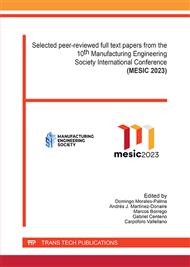p.22
p.31
p.43
p.53
p.61
p.70
p.79
p.89
p.99
Analyzing the Influence of Dressing Parameters on the Real Depth of Cut during Rotary Dressing of Vitrified Bonded CBN Grinding Wheels
Abstract:
Grinding is a widely used process in many industries due to the precise geometric tolerances and excellent surface finishes it can offer, which makes it very useful when high quality parts have to be manufactured. Due to the wear that the grinding wheel suffers, a process known as dressing is periodically carried out to recover the cutting ability of the wheel. Dressing is an extremely important part of the grinding process, as it can alter and improve the cutting conditions of the wheel.During the dressing of vitrified bonded CBN wheels, the real dressing depth of cut is significantly lower than the theoretical depth of cut, leading to dimensional errors in the dressed grinding wheel, which consequently translate into the ground part. However, while deformations during grinding have been widely studied, this phenomenon has not been yet analyzed during dressing. Therefore, the main objective of this work is to determine the influence of the dressing parameters on the real depth of cut. Also, the effect of dresser wear and the deformations has been determined separately.To this end, a new methodology has been developed to measure the real depth of cut using a laser displacement sensor. Moreover, experimental tests have been carried out to characterize the influence that the dressing speed ratio (qd) and set depth of cut (ad_set) have on the actual depth of cut (ad_real). It has been seen that the use of negative qd results in a more accurate real depth of cut, and therefore a more efficient dressing process. While the error using negative qd is about 10 %, using positive qd is about 25 %.
Info:
Periodical:
Pages:
61-69
Citation:
Online since:
October 2023
Authors:
Keywords:
Price:
Сopyright:
© 2023 Trans Tech Publications Ltd. All Rights Reserved
Share:
Citation:



